Mechanized Technology Research and Equipment Application of Banana Post-Harvesting: A Review
Abstract
1. Introduction
2. Materials and Methods
2.1. Banana Picking
2.2. Banana Transportation
2.3. Banana De-Handing
3. Results
4. Conclusions
Author Contributions
Funding
Conflicts of Interest
References
- Zhang, J.Y.; Zhang, F. Statistical analysis of global banana import and export from 2008 to 2017. China Fruit Ind. Inf. 2019, 36, 21–27. [Google Scholar]
- Wang, F.; Xie, J.H.; Guo, J.C.; Ke, Y.P.; Zhou, D.B. Development of China’s banana industry in 2017 and development trends and countermeasures in 2018. Chin. Trop. Agric. 2018, 1, 27–32. [Google Scholar]
- Xie, J.H. 70 years of fruit science research in new china-banana. J. Fruit Trees 2019, 36, 1429–1440. [Google Scholar]
- Production/Yield Quantities of Bananas in the World. Food and Agriculture Organization of the United Nations. Available online: http://www.fao.org/economic/est/est-commodities/bananas/bananafacts/en/#.XhvGM0cza (accessed on 12 December 2019).
- Yang, Z.; Yan, L.L.; Li, J.; Wang, W.Z.; Wang, L.Y. Orchard mining and transportation mechanized equipment and technology. In Proceedings of the 2011 Annual Conference of the Chinese Academy of Agricultural Engineering, Chongqing, China, 22 October 2011; pp. 167–174. [Google Scholar]
- Massachusetts Institute of Technology. Banana Harvester. Available online: http://web.mit.edu/2.009_gallery/www/2005/Banana/2005_Banana_Assembly.html (accessed on 22 December 2019).
- Jason, A. A Device that Assists Banana Famers in Removing Banana Bunches from Trees. Available online: http://web.mit.edu/2.009_gallery/www/2005/Banana/2005_Banana_Mockup.html/2005/ (accessed on 18 July 2017).
- Wang, X.C.; Wang, Y.; Lu, Y.Z.; Chen, Y.L.; Zeng, S.C.; Li, J.; Lin, R.G. Auxiliary Device for Chopping Bananas. Chinese Patent No. CN201185577, 28 January 2009. [Google Scholar]
- Yang, S.X.; Zhu, L.X.; Zhang, R.H.; Tian, X.F. Structural design of flexible clamping device for banana bunch harvesting. Mod. Agric. Equip. 2018, 1, 51–55. [Google Scholar]
- Wang, H.J.; Tang, Z.F.; Zhao, R.M.; Zou, X.J. Simulation and optimization design of gripper for banana picking manipulator. Mech. Des. Manuf. 2015, 1, 161–164. [Google Scholar]
- Wang, H.J.; Huang, G.G.; Chen, J.X.; Zou, X.J. Structural design and prototype test of banana picking manipulator. Mech. Des. 2013, 30, 13–17. [Google Scholar]
- Wang, H.J.; Huang, G.G.; Zou, X.J.; Chen, Y. Modeling and performance simulation for a picking manipulator based on model. Key Eng. Mater. 2014, 579, 467–475. [Google Scholar]
- Wang, H.J.; Huang, G.G.; Chen, J.X.; Zou, X.J. Structure design and modeling for a picking bananas manipulator. Adv. Mater. Res. 2013, 605, 204–209. [Google Scholar] [CrossRef]
- Wang, H.J.; Chen, J.X.; Zou, X.J.; Liu, C.Y. Structure design and multi-domain modeling for a picking banana manipulator. Adv. Mater. Res. 2010, 97, 3560–3564. [Google Scholar] [CrossRef]
- Wang, H.J.; Li, X.F.; Huang, G.G.; Zou, X.J. Design and simulation of banana picking manipulator grab mechanism. J. Nat. Sci. Xiangtan Univ. 2012, 34, 114–117. [Google Scholar]
- Tang, Z.F. Experiment and Simulation Analysis of Banana Picking Manipulator; South China Agricultural University: Guangzhou, China, 2016. [Google Scholar]
- Xiao, M. Banana picking machine. World Agric. 1986, 1, 50. [Google Scholar]
- Transform Australia. Mechanical Banana Harvester. Available online: http://www.transformaustra-lia.com.au/harvest.html (accessed on 10 July 2017).
- Wang, Y. Research on Key Technologies of Banana Orchard Harvester; South China Agricultural University: Guangzhou, China, 2019. [Google Scholar]
- Zhu, D.Y.; Qu, J.Y.; Xu, L.Q.; Zhang, B.Z.; Ji, X. Structural design of guide rail mobile banana picker. Food Mach. 2018, 34, 92–94. [Google Scholar]
- Li, Y.P.; Ma, G.X.; Ma, J.S.; Wang, X.Z.; Zhang, J. UG simulation based on new electric cutting banana harvester. Agric. Mech. Res. 2016, 38, 61–65. [Google Scholar]
- Li, H.H. Study on design of banana picking machine. Technol. Horiz. 2013, 1, 65–66. [Google Scholar]
- LIobet, E.; Hines, E.L.; Gardner, J.W. Nondestructive banana ripeness determination using a neural network-based electronic nose. Meas. Sci. Technol. 1999, 10, 538–548. [Google Scholar] [CrossRef]
- Zou, X.J.; Li, J.; Sun, Q.; Chen, Y.L.; Zou, H.X.; Wang, H.J.; Chen, Y. Research on virtual design and simulation system of picking manipulator. J. Syst. Simul. 2010, 22, 2748–2752. [Google Scholar]
- Fu, L.H.; Duan, J.L.; Zou, X.J.; Lin, G.C.; Song, S.S.; Yang, Z. Banana detection based on color and texture features in the natural environment. Comput. Electron. Agric. 2019, 167, 105057. [Google Scholar] [CrossRef]
- Liang, R. Remote sensors will revolutionize banana production. China Fruit Ind. Inf. 2019, 36, 44. [Google Scholar]
- Li, Z.Z.; Zhu, L.X.; Ma, Z.Y. Status of banana harvesting technology and countermeasures of mechanized production. World Trop. Agric. Inf. 2013, 1, 23–27. [Google Scholar]
- Thompson, A.K. Fruit and Vegetables: Harvesting, Handling and Storage, Volume 1: Introduction and Fruit, 3rd ed.; John Wiley & Sons: Hoboken, NJ, USA, 2008. [Google Scholar]
- Fernando, I.; Fei, J.; Stanley, R. Assessment and Characterizing Mechanical Damage in Packaged Bananas in the Postharvest Supply Chain; EDP Sciences: Paris, France, 2019. [Google Scholar]
- Magalhães, M.J.M.D.; Abrahão, R.F.; Leal, P.A.M. Manual transportation within the plot and physical damages to bananas. Sci. Agric. 2004, 61, 32–35. [Google Scholar] [CrossRef]
- Fernando, I.; Fei, J.; Stanley, R. Measurement and analysis of vibration and mechanical damage to bananas during long distance interstate transport by multi-trailer road trains. Postharvest Biol. Technol. 2019, 158, 110977. [Google Scholar] [CrossRef]
- Maia, V.M.; Salomao, L.C.; Siqueira, D.L. Types and intensity of mechanical damages on ‘Prata Ana’ bananas along the commercialization chain. Rev. Bras. De-Fruit Cult. 2008, 30, 365–370. [Google Scholar] [CrossRef]
- Zhao, Z.L. A Combined Back Frame for Banana Picking. Chinese Patent No. CN2717280, 17 August 2005. [Google Scholar]
- Nong, Z.R.; Tang, Z.P.; Yang, C.P.; Liang, Y.P. Postharvest banana processing status and problems in China. Guangxi Trop. Agric. 2009, 1, 17–20. [Google Scholar]
- Li, D.A. Postharvest commercialization of bananas. Chin. Trop. Agric. 2006, 1, 40–41. [Google Scholar]
- Yan, L.L.; Yang, Z.; Li, J.; Chen, C.H. Design and test of banana transport frame. Agric. Mech. Res. 2013, 35, 168–170. [Google Scholar]
- Cai, J.L. Design and Test of Banana Field Cleaning Vehicle; Zhongkai University of Agriculture and Engineering: Guangzhou, China, 2015. [Google Scholar]
- Li, Z.Z. Design and Test of Banana Field Transporter; Zhongkai University of Agriculture and Engineering: Guangzhou, China, 2014. [Google Scholar]
- Zhu, L.X.; Li, Z.Z.; Ma, Z.Y.; Liu, S.D. Structural design and trial production of wheeled banana transport trolley. J. Zhongkai Univ. Agric. Eng. 2016, 29, 1–4. [Google Scholar]
- Ma, Z.Y.; Li, Z.Z.; Zhu, L.X.; Chen, A.; Yin, S.H. Design of banana transport trolley control system. J. Zhongkai Univ. Agric. Eng. 2016, 29, 10–15. [Google Scholar]
- Subra, P. The cableway method of conveying bunches in a banana plantation. Fruits Paris 1971, 26, 807–817. [Google Scholar]
- Huang, X.Z. Status and analysis of banana harvesting technology in Baise City. Guangxi Agric. J. 2006, 1, 26–27. [Google Scholar]
- Kemp, D.C.; Matthews, M.D.P. Banana conveyor. Overseas Dev. Tech. Bull. 1977, 7, 325–331. [Google Scholar]
- Li, S.P.; Chen, W.H. Report on Ecuador’s banana industry management experience. Trop. Agric. Sci. 2000, 1, 42–45. [Google Scholar]
- Valdés-hernández, P.A.; Martínez-rodríguez, A.; Suárez-hernández, J. Theoretical model of a transportation system for banana bunches in hillsides. Rev. Cienc. Técnicas Agropecu. 2018, 27, e989. [Google Scholar]
- Wang, C.Q. Ecuador and Philippines banana harvest packaging technology and introduction. Chin. Trop. Agric. 2005, 1, 20–21. [Google Scholar]
- Li, J.; Yang, Z.; Lu, H.Z.; Lin, J.S.; Yan, L.L.; Guo, J.W. Study on the dynamics of the electric carrier ropeway transportation system in banana orchards. Trans. Chin. Soc. Agric. Mach. 2013, 44, 211–216. [Google Scholar]
- Yang, Z.; Li, J.; Wang, W.Z.; Zheng, S.Y.; Ding, L.H.; Xu, G.Q. Electric Banana Delivery System. Chinese Patent No. CN102502199A, 20 June 2012. [Google Scholar]
- Hong, T.S.; Su, J.; Zhu, Y.Q.; Yue, X.J.; Song, S.R.; Yang, Z. Fruit Delivery System Suitable for Orchard. Chinese Patent No. CN101607632, 23 December 2009. [Google Scholar]
- Hong, T.S.; Su, J.; Chen, S.; Ouyang, Y.P.; Zhu, Y.Q.; Song, S.R.; Yang, Z.; Yue, X.J.; Li, Z.; Wu, W.B. Wire Rope Traction Changing Track Type Mountain Transportation System Suitable for Orchard. Chinese Patent No. CN102730007A, 17 October 2012. [Google Scholar]
- Sun, L.H.; Zhou, K.H. Application research on comprehensive nursing and harvesting packaging of banana fruit. Yunnan Agric. Sci. Technol. 2007, 1, 18–21. [Google Scholar]
- Fan, G.L. Nondestructive harvesting of bananas and postharvest commodity processing technology. Agric. Technol. 2012, 32, 104. [Google Scholar]
- Li, Y.P.; Fang, J.; Dong, D.C.; Liang, W.H.; Liu, Y.Q.; Gu, X.L. Analysis on the development status and trend of the world banana industry. Guangdong Agric. Sci. 2008, 1, 115–119. [Google Scholar]
- Zhou, K.H.; Yang, J.H. Analysis of mechanized management of banana production. Trop. Agric. Technol. 2010, 33, 24–25. [Google Scholar]
- Jin, Z.Q.; Wang, J.S.; Xu, B.Y.; Miao, H.X. Banana de-Handing Cutter. Chinese Patent No. CN202979733U, 12 June 2013. [Google Scholar]
- Merino, G.; Dasilva, L.; Mattos, D. Ergonomic evaluation of the musculoskeletal risks in a banana harvesting activity through qualitative and quantitative measures, with emphasis on motion capture (Xsens) and EMG. Int. J. Ind. Ergon. 2019, 69, 80–89. [Google Scholar] [CrossRef]
- Yang, Z.; Zhu, Z.B.; Duan, J.L.; Sun, J.F.; Zhang, Z.W.; Huang, Y.Q.; Gu, Y.; Hu, J.Y. Reversible Self-Locking Device for Clamping Banana Bunch Stalk. Chinese Patent No. CN105773465A, 20 July 2016. [Google Scholar]
- Yang, Z.; Zhu, Z.B.; Duan, J.L.; Sun, J.F.; Qiu, H.; Chen, Z.C.; Zhu, Q.C.; Sun, Z.Q. SELF-Locking Device for Clamping Banana Bunch Stalk. Chinese Patent No. CN105773463A, 20 July 2016. [Google Scholar]
- Zhu, Z.B.; Yang, Z.; Sun, J.F.; Xue, K.P.; Niu, M.M.; Qiu, H.; Chen, Z.C.; Zhu, Q.C.; Sun, Z.Q. Parameter optimization and experiment of pneumatic holding part for banana crown cutting. Trans. Chin. Soc. Agric. Eng. 2016, 32, 33–39. [Google Scholar]
- Yang, Z.; Xu, Z.Y.; Jin, M.H.; Zhu, Z.B.; Li, J.; Wen, F.J.; Guo, J.; Duan, J.L.; Yao, H.L. Experimental study on clamping safety margin of a banana stem gripper. IFAC PapersOnLine 2018, 51, 560–564. [Google Scholar] [CrossRef]
- Chen, Y.; Xue, S.L.; Xu, B. Test of physical and chemical properties of banana fiber. Prog. Text. Sci. Technol. 2012, 1, 56–61. [Google Scholar]
- Chen, M. Characteristics difference between banana fiber, flax and ramie fiber. J. Ningbo Univ. 2010, 23, 109–112. [Google Scholar]
- Zhu, Z.B. Research on Key Techniques of Banana Mechanical de-Handing; South China Agricultural University: Guangzhou, China, 2017. [Google Scholar]
- Chen, Z.C. Study on Cutting Characteristics and de-Handing Process of Banana Crown; South China Agricultural University: Guangzhou, China, 2017. [Google Scholar]
- Chen, Z.C.; Yang, Z.; Zhu, Z.B.; Niu, M.M.; Zhu, Q.C.; Sun, Z.Q.; Gu, Y. Structural characteristics and mechanical properties of banana crown. Jiangsu Agric. Sci. 2017, 45, 223–227. [Google Scholar]
- Yang, Z.; Duan, J.L.; Zhu, Z.B.; Li, J.; Yan, G.Q. A Rotary Banana de-Handing Machine. Chinese Patent No. CN103141321A, 12 June 2013. [Google Scholar]
- Duan, J.L.; Yang, Z.; Zhu, Z.B. Insert-Cut and Variable-Diameter Banana de-Handing Cutter of Adapting to Banana Bunch Stalk. Chinese Patent No. CN103584264A, 19 February 2014. [Google Scholar]
- Duan, J.L.; Zhu, Z.B.; Yang, Z. Variable Diameter and Insert-Cut Ring Banana de-Handing Device. Chinese Patent No. CN104126369A, 5 November 2014. [Google Scholar]
- Yang, Z.; Duan, J.L.; Li, J.; Zhu, Z.B.; Xu, Z.Y.; Wang, Z.J. An Insert-Cut Banana de-Handing Tool. Chinese Patent No. CN106900280B, 22 March 2019. [Google Scholar]
- Yang, Z.; Wen, F.J.; Zhu, Z.B. Banana crown-cut by inserting cut type and mechanical model analysis of thick cutter. J. Taiwan Agric. Eng. 2018, 64, 49–62. [Google Scholar]
- Xu, Z.Y.; Yang, Z.; Zhu, Z.B. Parameter optimization of banana crown-cutting machine using combined cutters. Curr. Sci. 2019, 117, 492–497. [Google Scholar] [CrossRef]
- Yang, Z.; Guo, J.; Jin, M.H.; Xu, Z.Y.; Duan, J.L.; Mo, J.S.; Jin, H. Insert-Cut Banana de-Handing Device of Adaptively Embracing Banana Bunch Stalks. Chinese Patent No. CN108720059B, 13 August 2019. [Google Scholar]
- Yang, Z.; Guo, J.; Jin, M.H.; Xu, Z.Y.; Duan, J.L.; Mo, J.S.; Jin, H. Variable Diameter Adaptive Rotary Cutting Banana de-Handing Tool. Chinese Patent No. CN108576877B, 15 November 2019. [Google Scholar]
- Yang, Z.; Guo, J.; Jin, M.H.; Duan, J.L.; Fu, H.; Xu, Z.Y. Design and analysis of self-adaptability in banana crown-cutting device based on constant-force mechanism. Trans. Chin. Soc. Agric. Mach. 2019, 50, 148–155. [Google Scholar]
- Yang, Z.; Xu, Z.Y.; Duan, J.L.; Jin, M.H.; Sun, J.F.; Guo, J. A Variable Arc Mechanism. Chinese Patent No. CN107598603B, 10 September 2019. [Google Scholar]
- Xu, Z.Y. Research on the Mechanism of Banana Profiling Cutting Based on Vibration Cut; South China Agricultural University: Guangzhou, China, 2019. [Google Scholar]
- Xu, Z.Y.; Yang, Z.; Duan, J.L.; Jin, M.H.; Mo, J.S.; Zhao, L.; Guo, J.; Yao, H.L. Design and experiment of symmetrical shape deployable arc profiling mechanism based on composite multi-cam structure. Symmetry 2019, 11, 958. [Google Scholar] [CrossRef]
- Yang, Z.; Xu, Z.Y.; Duan, J.L.; Jin, M.H.; Sun, J.F.; Guo, J. A Wire Saw Cutting Device. Chinese Patent No. CN107637271B, 9 July 2019. [Google Scholar]
- Yang, Z.; Zhu, Z.B.; Duan, J.L.; Sun, J.F.; Zhang, Z.W.; Huang, Y.Q.; Gu, Y.; Hu, J.Y. Plane Bidirectional Staggered Synchronous Conveying Banana Hands Device. Chinese Patent No. CN105730990A, 6 July 2016. [Google Scholar]
- Zhang, X.R.; Wang, C.; Liang, D.; Li, Y. Experiment of parameter optimization of fiber roller-scraping device for banana stalk. Trans. Chin. Soc. Agric. Eng. 2016, 32, 55–62. [Google Scholar]
- Zhang, X.R.; Wang, Z.Q.; Li, Y.; Liang, D. Design and experiment of sliding-cutting and anti-twining returning device for banana straw. Trans. Chin. Soc. Agric. Eng. 2018, 34, 26–34. [Google Scholar]
- Zhang, X.R.; Liang, D.; Li, Y.; Wang, C. Development and experiment of full feeding and movable combined machine for banana stalk fiber extraction. Trans. Chin. Soc. Agric. Eng. 2015, 31, 22–30. [Google Scholar]
- Xu, S.Y.; Zhang, Y.C.; Li, J.H.; Lin, C.; Lin, Z.H. Research progress and improvement direction of squeezing dehydration technology and equipment of banana pseudo-stem. Trans. Chin. Soc. Agric. Eng. 2018, 34, 76–84. [Google Scholar]
- Adeniyi, A.G.; Ighalo, J.O.; Onifade, D.V. Banana and plantain fiber-reinforced polymer composites. J. Polym. Eng. 2019, 39, 597–611. [Google Scholar] [CrossRef]
- Wijianto, W.; Ibnu, R.M.D.; Adityarini, H. Effect of NaOH Concentration Treatment on Tensile Strength, Flexure Strength and Elasticity Modulus of Banana Fiber Reinforced Polyester Resin; Trans Tech Publications Ltd.: Surakarta, Indonesia, 2019. [Google Scholar]
- Velasquez-cock, J.; Castro, C.; Ganan, P. Influence of the maturation time on the physical-chemical properties of nanocellulose and associated constituents isolated from pseudo-stems of banana plant c.v. Valery. Ind. Crop. Prod. 2015, 83, 551–560. [Google Scholar] [CrossRef]
- Balakrishnan, S.; Wickramasinghe, G.L.D.; Wijayapala, U.G.S. Investigation on improving banana fiber fineness for textile application. Text. Res. J. 2019, 89, 4398–4409. [Google Scholar] [CrossRef]
- Xia, Y.K.; Zhang, J.; Guo, J.C. Empirical analysis of the contribution rate of banana production technology progress in China. Guangdong Agric. Sci. 2015, 42, 184–188. [Google Scholar]
- Su, J.L.; Liu, Y.L.; Wu, J.D. Research status and development trend of banana picking machinery. J. China Agric. Univ. 2019, 24, 131–137. [Google Scholar]
- Zou, D.M.; Li, M.; Gao, Z.Y.; Li, C.X.; Yuan, H.Q.; Feng, X.P.; Hu, M.J. Banana harvesting, storage and transportation preservation technology. Chin. Trop. Agric. 2018, 1, 76–77. [Google Scholar]
- Jin, Z.; Liu, J.H. Analyze the role of science and technology in China’s banana industry. Trop. Agric. Sci. 2018, 38, 100–104. [Google Scholar]
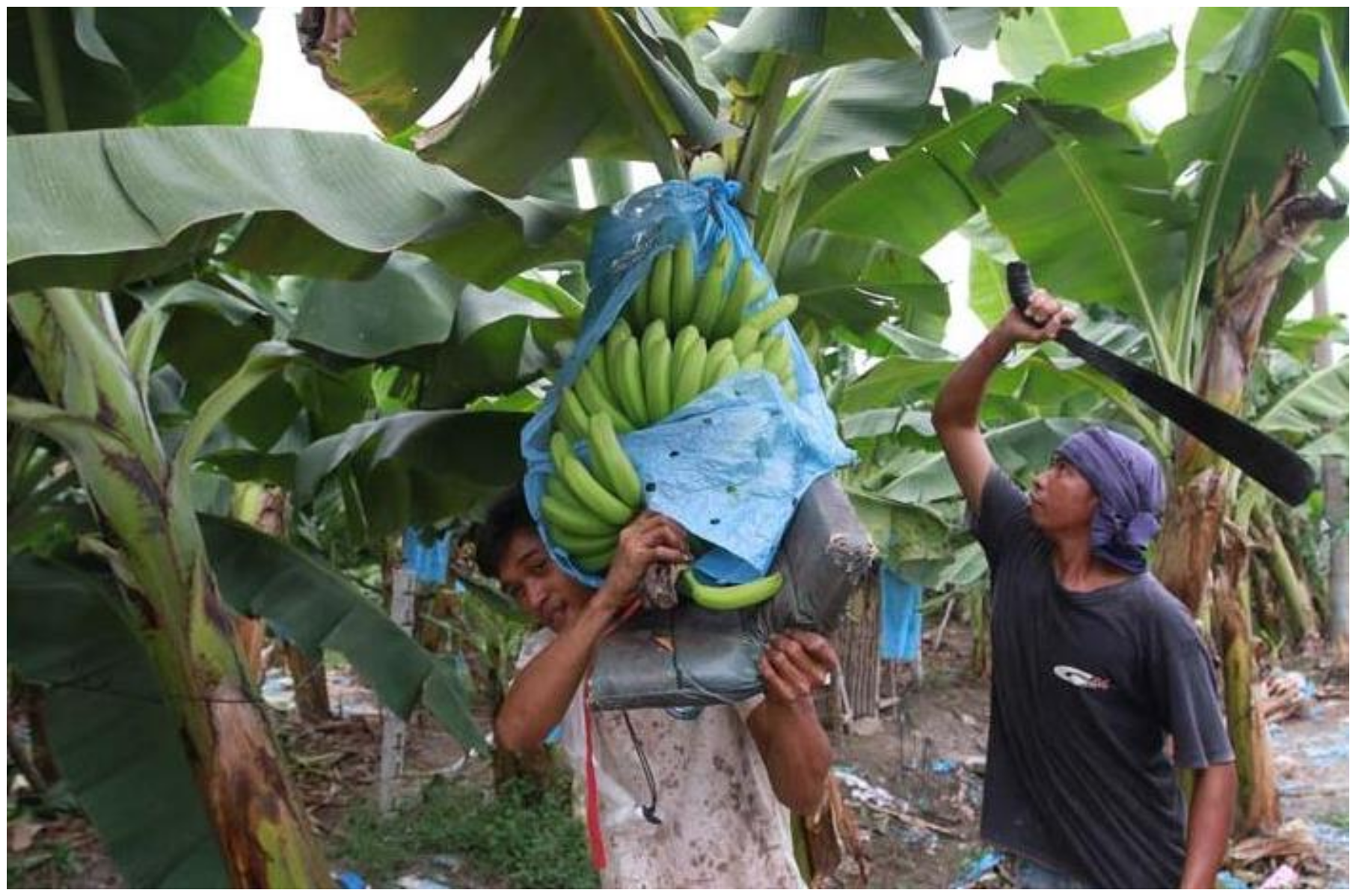
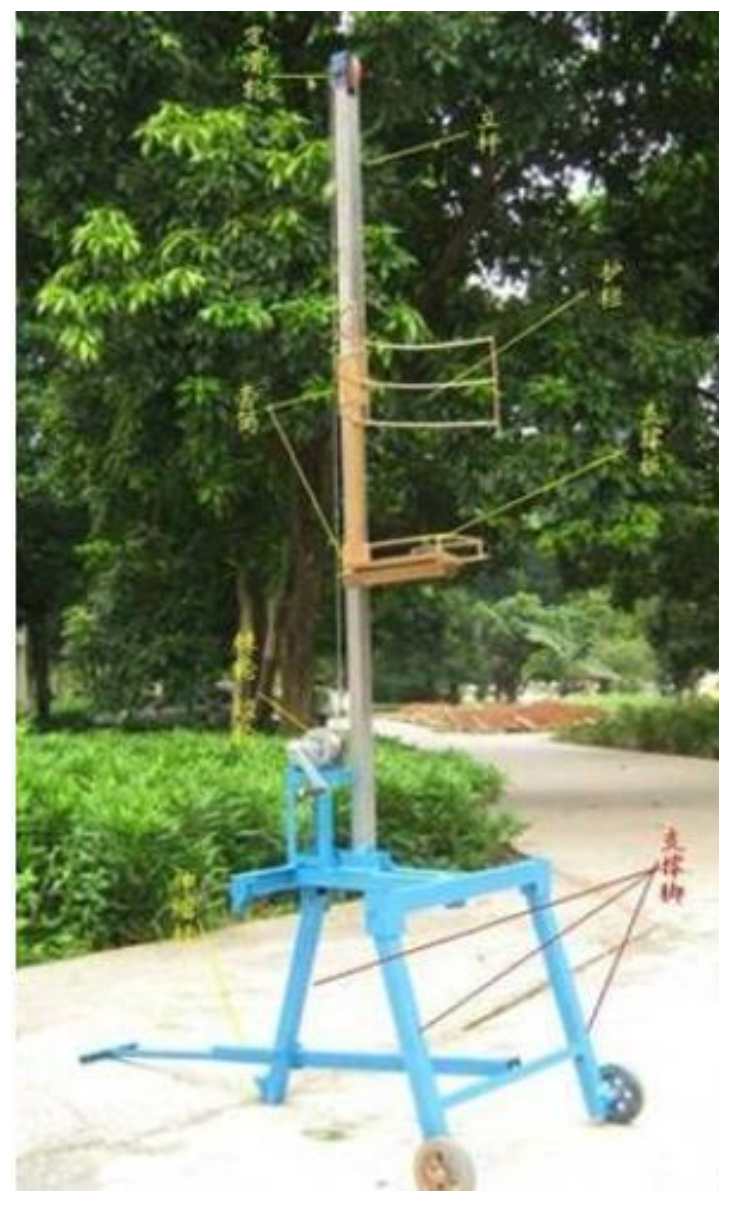
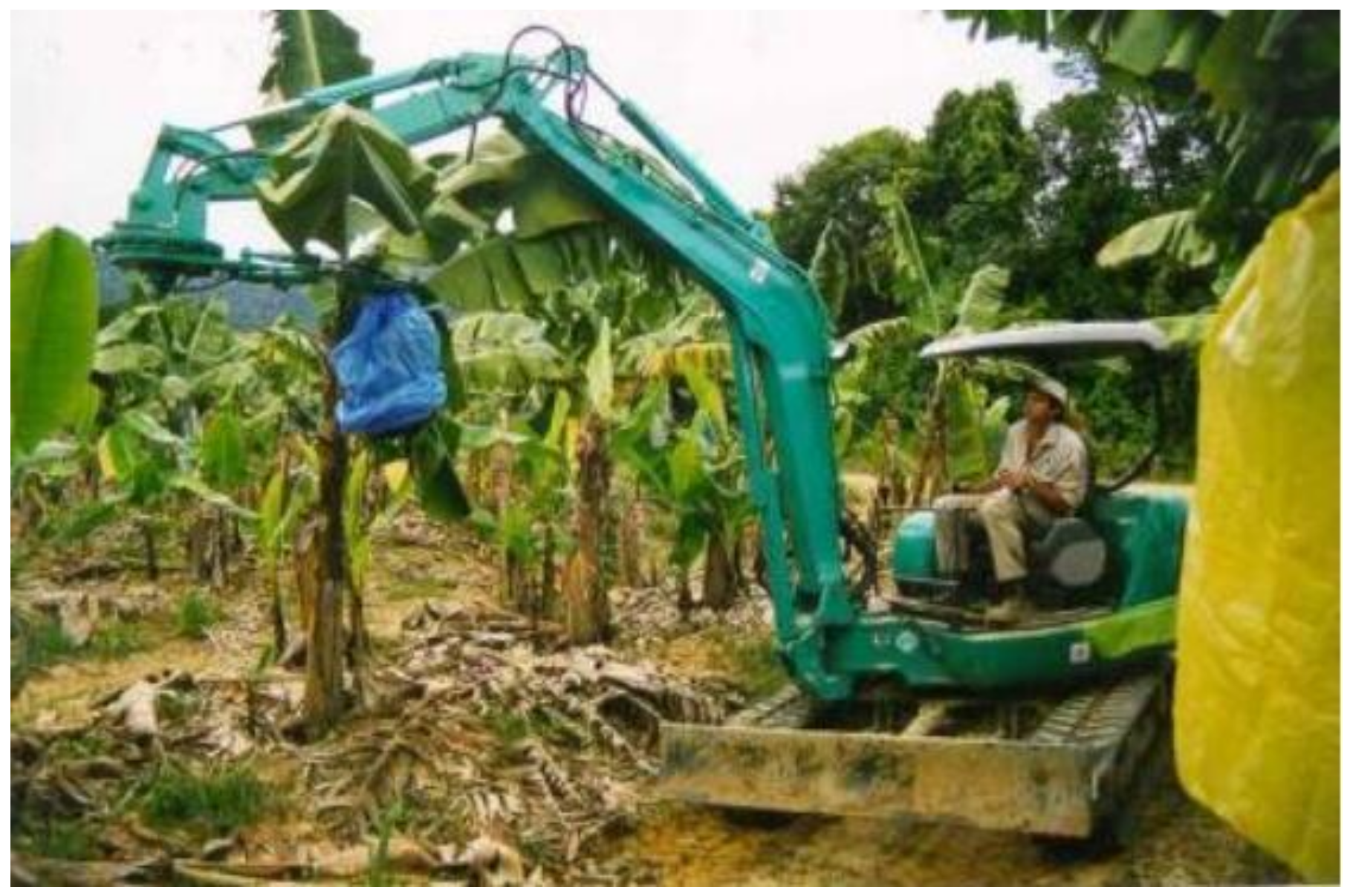
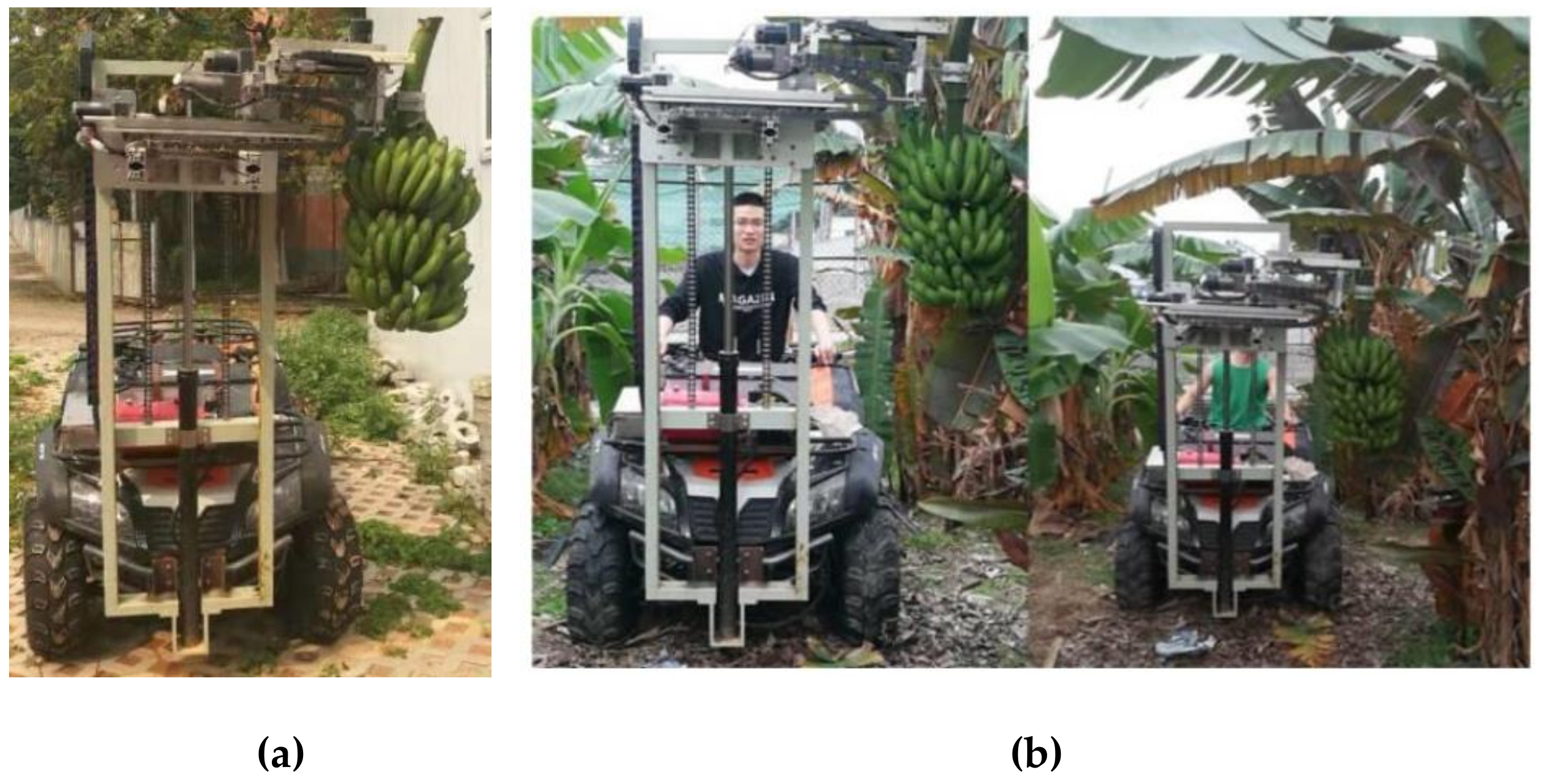
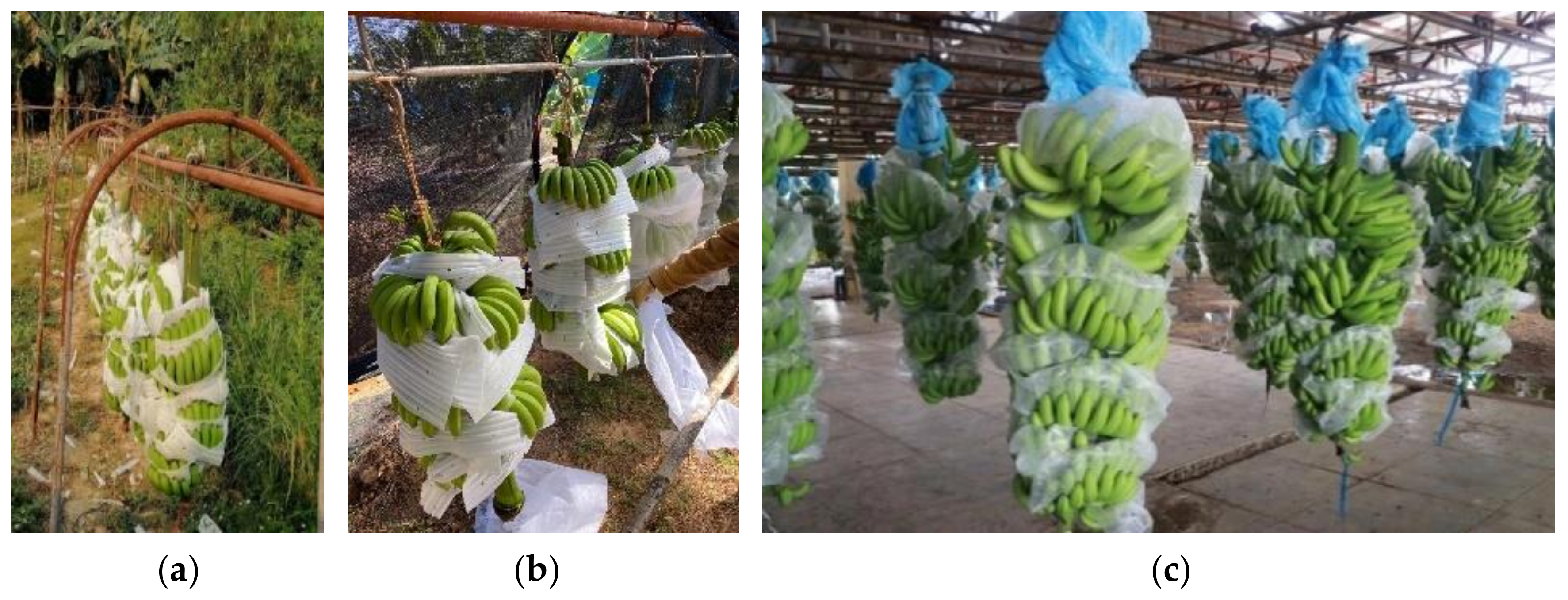
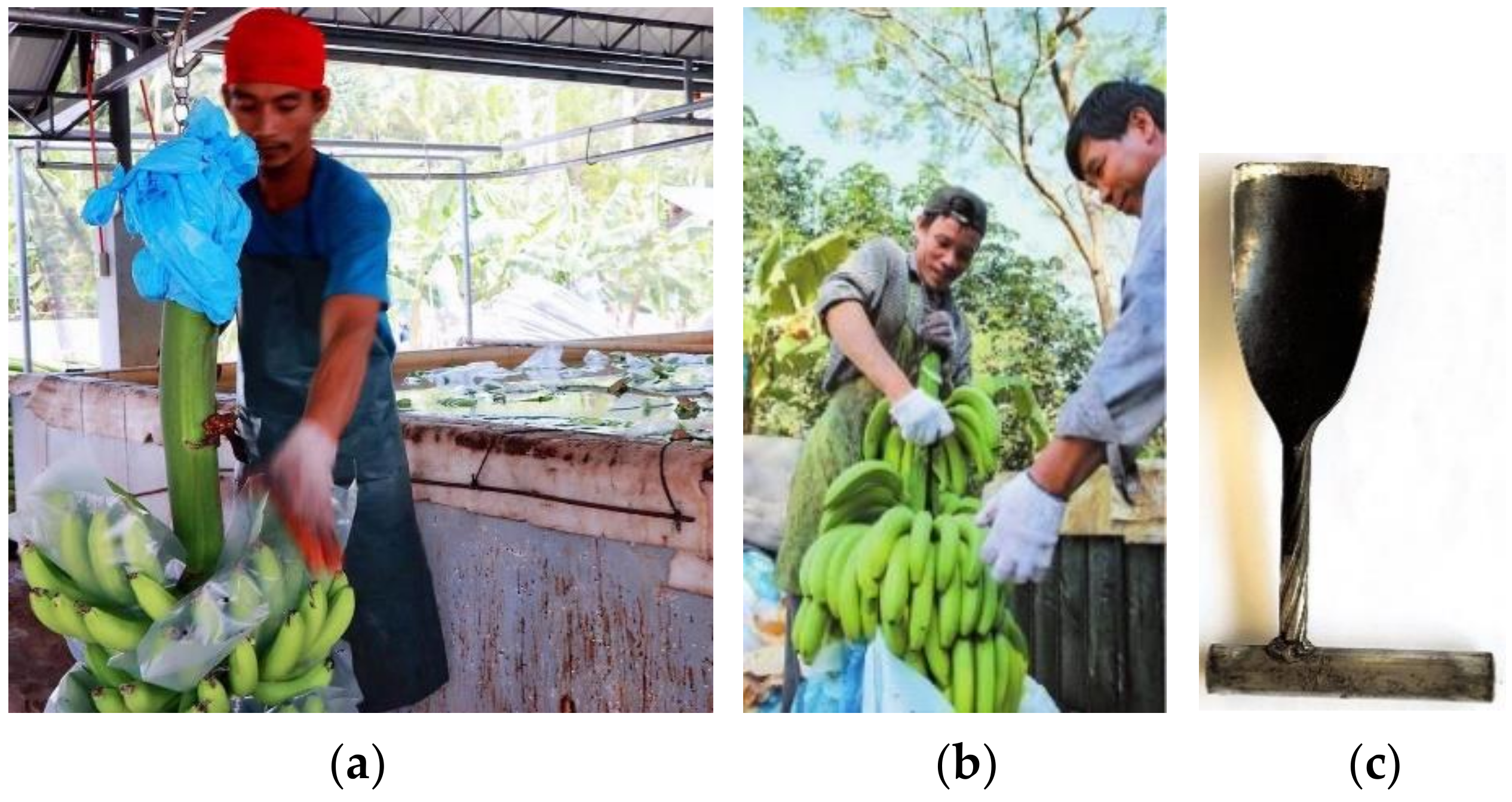
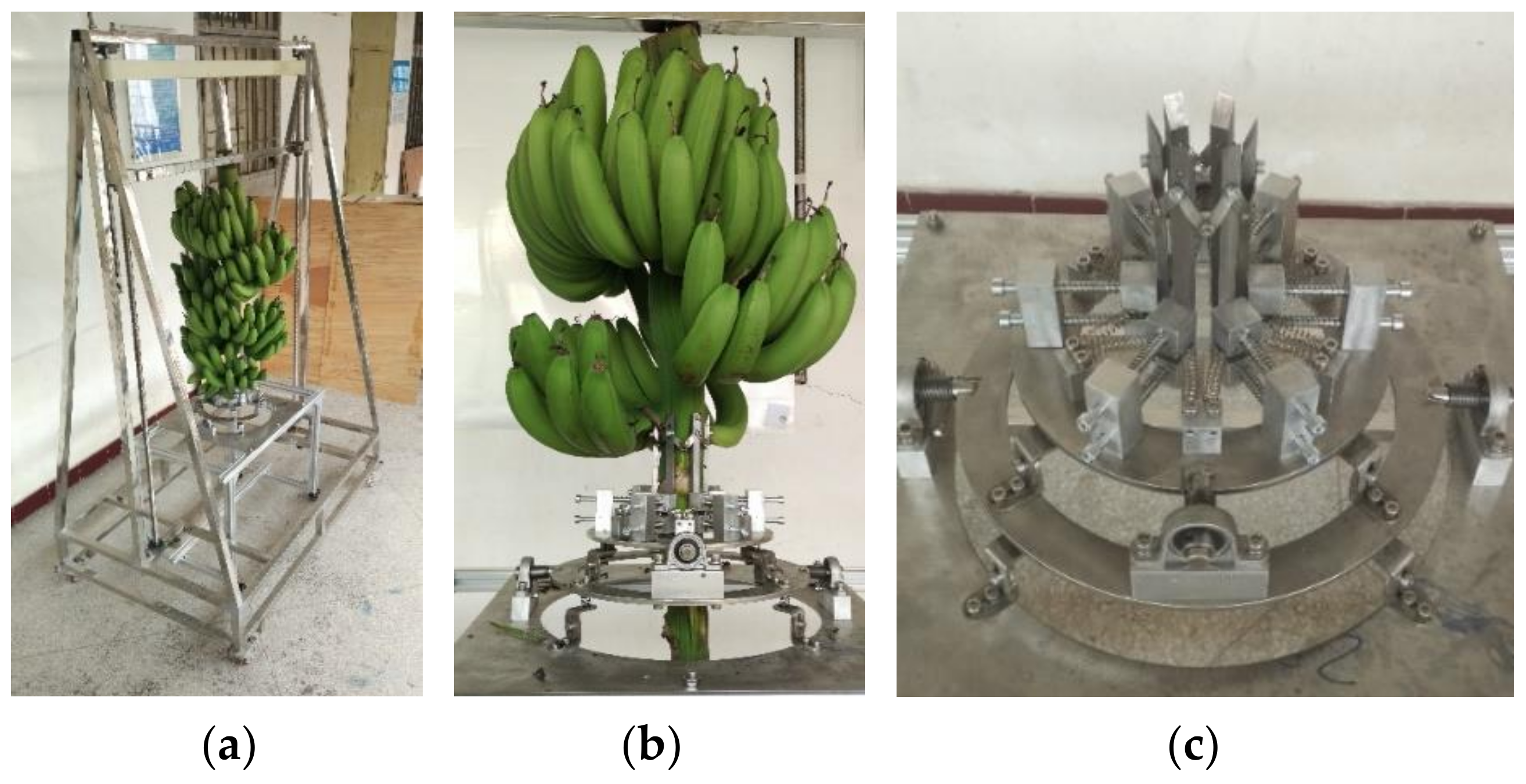
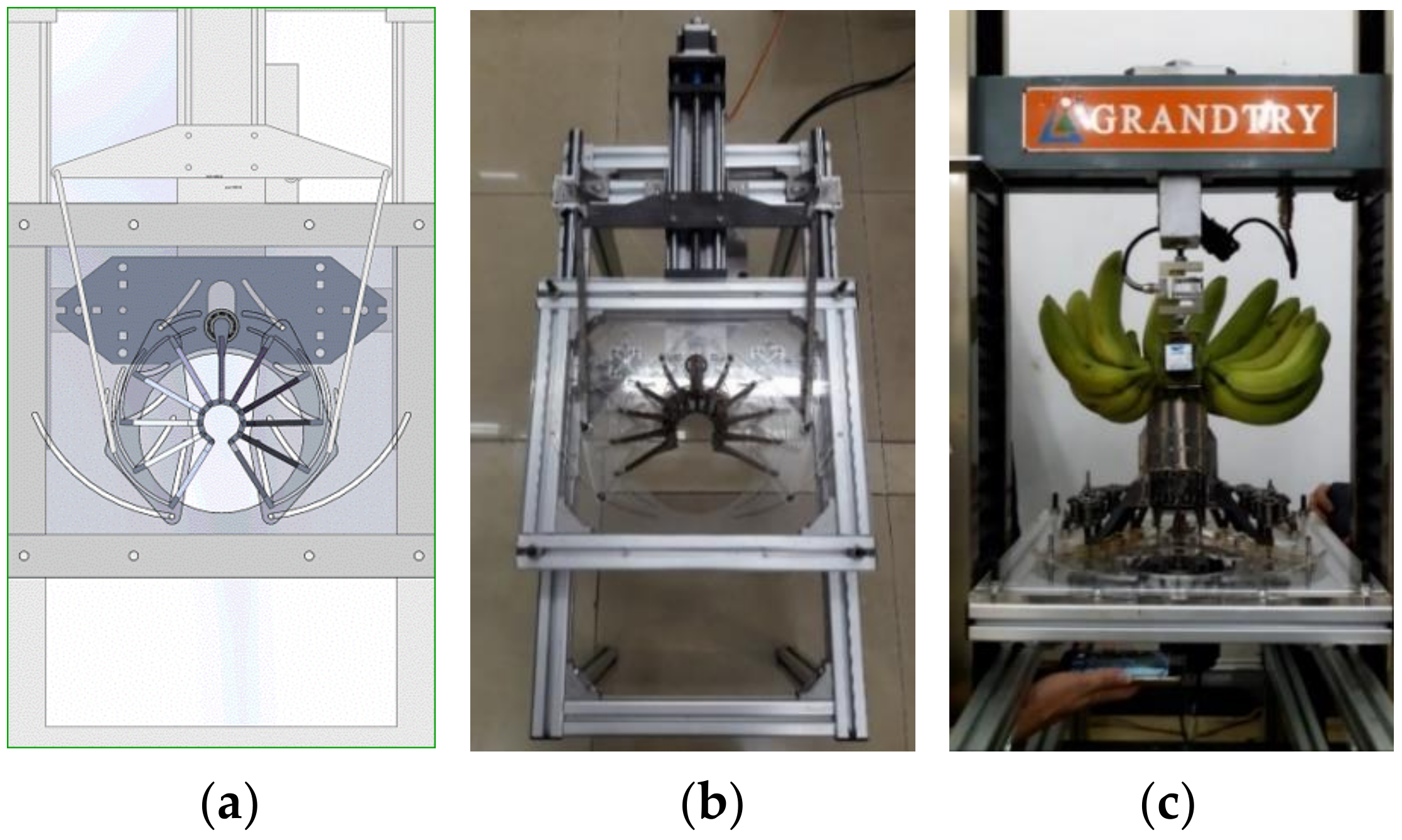
© 2020 by the authors. Licensee MDPI, Basel, Switzerland. This article is an open access article distributed under the terms and conditions of the Creative Commons Attribution (CC BY) license (http://creativecommons.org/licenses/by/4.0/).
Share and Cite
Guo, J.; Duan, J.; Li, J.; Yang, Z. Mechanized Technology Research and Equipment Application of Banana Post-Harvesting: A Review. Agronomy 2020, 10, 374. https://doi.org/10.3390/agronomy10030374
Guo J, Duan J, Li J, Yang Z. Mechanized Technology Research and Equipment Application of Banana Post-Harvesting: A Review. Agronomy. 2020; 10(3):374. https://doi.org/10.3390/agronomy10030374
Chicago/Turabian StyleGuo, Jie, Jieli Duan, Jun Li, and Zhou Yang. 2020. "Mechanized Technology Research and Equipment Application of Banana Post-Harvesting: A Review" Agronomy 10, no. 3: 374. https://doi.org/10.3390/agronomy10030374
APA StyleGuo, J., Duan, J., Li, J., & Yang, Z. (2020). Mechanized Technology Research and Equipment Application of Banana Post-Harvesting: A Review. Agronomy, 10(3), 374. https://doi.org/10.3390/agronomy10030374







